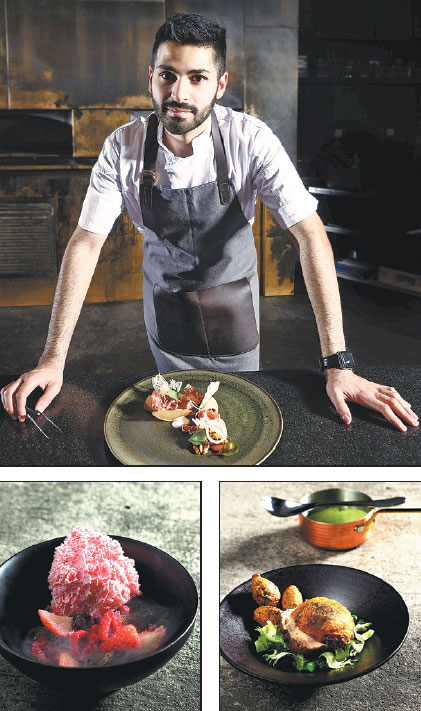Mediterranean muse
By Mike Peters (China Daily) Updated: 2017-02-14 07:16Chef Talib Hudda finds a new home for his culinary art, without losing his old capacity to surprise, Mike Peters discovers.
Food historians say the exotic-sounding fassolatha has been around since ancient Greek times, but it's probably never looked so good. In this dense version of the soup, white beans cooked in pesto are nested in a kidney-bean puree with basil oil, charred avocado and premium caviar. Meanwhile, the deceptively simple-sounding "pork and parsley", a dish of roasted suckling pork belly, teases the palate with the richly flavored meat, tomato ragout, parsley oil and za'atar crisps.
Chef Talib Hudda seems to have the savory flavors of every Mediterranean port at his fingertips. The only debate among his fans may be whether to grab a fork or a cellphone camera when the first plate comes out.
In 2015, Hudda took over the kitchen at The Georg, a brand-new fine-dining spot in Beijing. It was his first gig in Asia, and a local magazine review was simply headlined "Food Porn", followed by mouth-watering photos of his dishes.
Today, the 28-year-old Canadian chef finds himself helming the established Mediterranean restaurant Sureno at Opposite House, and once again, every bite lives up to the visual promise.
Under previous chefs, the restaurant's menu has in turn been Spanish and Italian. Hudda's reach is as wide as the entire Mediterranean. The sea is clearly his friend: Salmon carpaccio is rich and smoky. Squid gets a hint of nutty flavor from manchego, a Spanish cheese made with sheep's milk. Scallops meld with cauliflower and romesco, a nut and red-pepper sauce with roots in the Catalonia region of Spain.
Expanding Sureno's culinary footprint across the Mediterranean region means forays to North Africa as well as Europe. Hudda's playful touch with flavors and textures means embracing harissa for his braised lamb leg, and injecting tamarind as well as pine nuts into a torchon of foie gras. Beef cheek meets potato puree and charred leek, with savory cumin butter tying the flavors together oh so nicely.
The bottom line is fresh perspective that preserves the flavors of the region's well-loved cuisines.
Fans of Chinese cold noodles may be intrigued to find frozen rice-thread noodles in their dessert. One of several cleverly constructed sweets, Hudda's exquisite combination of rice, mandarin sorbet, dried lavender and rose petals is inspired by faloodeh, an ancient Persian treat. (Iran may not be precisely on the Mediterranean, but close enough.)
While his muse may be on the other side of the world, the chef is on the lookout to source many key ingredients locally, including fresh seasonal produce from Beijing and organically raised salmon from Sichuan province.
Hudda says he has been at home in the kitchen since early childhood - he started cooking with his grandmother at the age of 6. He enrolled in culinary school when he was just 16. Later, he worked in acclaimed restaurants around the world, from The Pear Tree in Vancouver to Marchal in Copenhagen, where he helped that kitchen team earn the restaurant's first Michelin star. To broaden his culinary horizons, he also ventured to New York for short stints at two of the city's top dining rooms, Cafe Boulud and Eleven Madison Park.
Earlier, he got the chance to represent his home country of Canada at the prestigious Bocuse d'Or in 2011.
"Nine months into culinary school, I met some chefs who were training for the competition," he told Time Out magazine last year. "I wasn't sure whether I wanted to stay in school and this was a rare and great opportunity to work with the country's best chefs in the world's most prestigious cooking competition. It was especially an honor to represent Canada, which is not exactly known for its culinary heritage, in a competition at this level."
His culinary training in Canada, his cross-cultural heritage and his experience in some top Copenhagen kitchens have been a winning combination so far in China. Hudda's unassuming manner and luminous smile when he makes a tableside visit are so casual that diners may be unprepared for the heights he aspires to with his food.
"Beijing is an exciting city to express my culinary creativity," he says, "because it has a deep respect for culinary traditions yet is hungry for innovations.
Contact the writer at michaelpeters@chinadaily.com.cn
If you go
LG/F, The Opposite House, 11 Sanlitun Road, Chaoyang district, Beijing. 010-6410-5240.
|
Clockwise from top: Chef Talib Hudda's creative plates include beef carpaccio, chicken globe with falafel and a strawberry semifreddo with chocolate cake. Photos Provided To China Daily |
- 'Cooperation is complementary'
- Worldwide manhunt nets 50th fugitive
- China-Japan meet seeks cooperation
- Agency ensuring natural gas supply
- Global manhunt sees China catch its 50th fugitive
- Call for 'Red Boat Spirit' a noble goal, official says
- China 'open to world' of foreign talent
- Free trade studies agreed on as Li meets with Canadian PM Trudeau
- Emojis on austerity rules from top anti-graft authority go viral
- Xi: All aboard internet express












